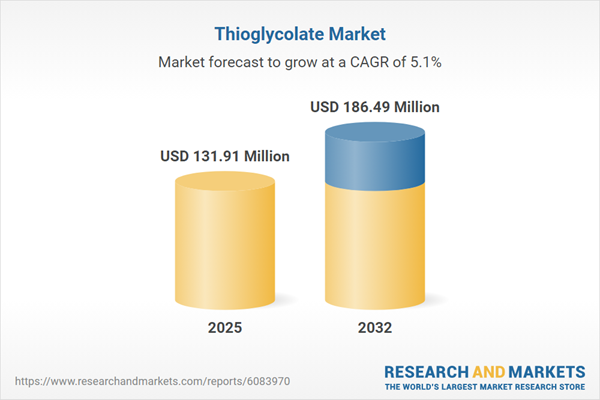Speak directly to the analyst to clarify any post sales queries you may have.
The thioglycolate market is progressing rapidly as shifts in end-user demand, regulatory landscapes, and product innovation reshape its global relevance. Senior leaders can use the insights below to drive competitive, risk-aware strategies and optimize market engagement in this dynamic sector.
Market Snapshot: Thioglycolate Market Growth and Dynamics
The Thioglycolate Market expanded from USD 125.67 million in 2024 to USD 131.91 million in 2025, with a continuing CAGR of 5.05% projected to reach USD 186.49 million by 2032. Market momentum is supported by advancements across application segments, including personal care, industrial processing, and sustainable chemistry. Regulatory scrutiny, increased investment in digital supply chain practices, and the pursuit of innovative green solutions are enabling organizations to strengthen their presence and adapt to change. Thioglycolate’s integration across diverse industries has enhanced its value proposition, driving operational resilience and customer-centric solutions globally.
Scope & Segmentation
This report provides a detailed breakdown of the thioglycolate market, enabling a clear view of application diversity and strategic opportunities:
- Applications: Coverage includes Hair Care (such as depilatory treatments and perms), Metal Surface Treatment, Pulp Bleaching, and Skin Care (available as creams and gels).
- End Use Industries: Analysis spans sectors like Metal Processing, Oil and Gas, Pulp and Paper, Textile, and Personal Care, each leveraging thioglycolate for unique operational benefits.
- Type Variants: Examines market demand for Ammonium, Calcium, and Monoethanolamine forms, highlighting formulation flexibility required by various manufacturers.
- Physical Forms: Focuses on Liquid and Powder categories, relevant for storage, handling, and application-specific processes.
- Distribution Channels: Evaluates trends in both Offline (Drugstores, Specialty Stores, Supermarkets/Hypermarkets) and Online sales, reflecting shifts in procurement preferences.
- Geographical Coverage: Thorough analysis includes the Americas, Europe, Middle East & Africa, and Asia-Pacific, considering regional regulatory, supply, and demand variations.
- Industry Players: Profiles major companies like BASF SE, The Dow Chemical Company, Eastman Chemical Company, LG Chem Ltd, Merck KGaA, Evonik Industries AG, Koninklijke DSM N.V., Kemira Oyj, Dongyue Group Limited, and Zibo Qixiang Tengda Chemical Co., Ltd.
Key Takeaways for Senior Decision-Makers
- Green synthesis and closed-loop manufacturing are emerging as leading approaches for environmental compliance and operational sustainability.
- Digitalization across supply chains supports improved forecasting, procurement responsiveness, and enhances security against potential disruptions.
- Personalization and clean-label trends are shaping product development, leading to novel thioglycolate-based solutions for differentiated consumer experiences.
- Localization strategies are being prioritized to offset supply chain risks and respond to the effects of new trade policies and tariffs.
- Strategic alliances among chemical producers and technology partners are fostering integrated innovations, streamlining production and amplifying efficiency.
- Geographical and regulatory diversity requires adaptive product and business models to address market fragmentation and changing local demands.
Tariff Impact: 2025 US Adjustments and Market Response
Impending changes in the United States tariff schedule for 2025 have prompted companies to reevaluate sourcing and distribution. Organizations importing thioglycolate intermediates are turning to alternative suppliers and investing in modular, localized production to limit risk. Contract terms are evolving, with the inclusion of flexible pricing to stabilize operations amid raw material cost changes. For high-volume segments such as personal care and pulp processing, these efforts enhance continuity and supply security in an unpredictable trade environment.
Market Research Methodology & Data Sources
This report deploys a multi-stage approach involving literature reviews, analysis of industry association documents, and in-depth executive and technical interviews. Key data were validated by triangulating customs records, financial statements, and scenario modeling. Robust quality control ensures findings are actionable and reliable for leadership teams.
Why This Report Matters for Executive Strategy
- Facilitates strategic positioning through granular market segmentation and thorough competitor benchmarking for executive-level decision-making.
- Highlights critical growth levers while providing actionable recommendations for managing regulatory, operational, and geopolitical risks.
- Delivers transparent research methodology and precisely validated data supporting robust planning and investment intelligence.
Conclusion
Success in the thioglycolate market depends on proactive alignment with regulatory shifts, adoption of emerging technologies, and adaptive supply chain management. Senior executives can leverage this report to inform strategic growth, policy adaptation, and operational resilience.
Table of Contents
3. Executive Summary
4. Market Overview
7. Cumulative Impact of Artificial Intelligence 2025
Companies Mentioned
The companies profiled in this Thioglycolate market report include:- BASF SE
- The Dow Chemical Company
- Eastman Chemical Company
- LG Chem Ltd
- Merck KGaA
- Evonik Industries AG
- Koninklijke DSM N.V.
- Kemira Oyj
- Dongyue Group Limited
- Zibo Qixiang Tengda Chemical Co., Ltd
Table Information
| Report Attribute | Details |
|---|---|
| No. of Pages | 182 |
| Published | November 2025 |
| Forecast Period | 2025 - 2032 |
| Estimated Market Value ( USD | $ 131.91 Million |
| Forecasted Market Value ( USD | $ 186.49 Million |
| Compound Annual Growth Rate | 5.0% |
| Regions Covered | Global |
| No. of Companies Mentioned | 11 |









